Media
Summary
Multiple international teams determine that a 2020 gamma-ray burst was actually a giant flare from a magnetar and that flare originated from a nearby galaxy. Plus, the Dark Energy Spectroscopic Instrument is ready for a new survey, NASA extends two planetary missions, and What’s Up in the night sky this next week.
Transcript
This is the Daily Space for today, Thursday, January 14, 2021. I am your host, Dr. Pamela Gay.
And I am your host, Beth Johnson.
And we are here to put science in your brain.
We’re past the midpoint of our Super Bowl of Astronomy, and this year’s virtual pressroom has been a bonanza of stories. We’ll probably be reporting on these stories well into next week, and we’re trying to get everything in that we can. Yesterday’s two press conferences were on the giant flare of a magnetar and the Dark Energy Spectroscopic Instrument’s results and upcoming new survey, and we’ll be covering the press releases presented today. Let’s get to it, shall we, Pamela?
The hottest topic of 2020 may have been magnetars, and that trend seems to be carrying over to 2021. These Manhattan-sized stars, back in more than a Sun’s worth of mass into a sphere roughly 20 miles across. This, by itself, just makes them dense objects called neutron stars. Add in some of the most powerful magnetic fields in the universe, and now you have a special kind of monster capable of releasing bursts of gamma rays capable of overexposing a camera from half a galaxy away and maybe even further.

On Wednesday, magnetar-studying scientists from around the world came together to present their work at the AAS meeting. These presentations were done over Zoom.
Random fact – the last time I was on a plane was to come home from last year’s AAS meeting.
In work presented by UC Berkeley researcher Kevin Hurley, we got the details on a high energy burst from a magnetar that occurred on April 15, 2020. Here I quote from the release:
Shortly before 4:42 a.m. EDT on that Wednesday, a brief, powerful burst of X-rays and gamma rays swept past Mars, triggering the Russian High Energy Neutron Detector aboard NASA’s Mars Odyssey spacecraft, which has been orbiting the planet since 2001. About 6.6 minutes later, the burst triggered the Russian Konus instrument aboard NASA’s Wind satellite, which orbits a point between Earth and the sun located about 930,000 miles (1.5 million kilometers) away. After another 4.5 seconds, the radiation passed Earth, triggering instruments on NASA’s Fermi Gamma-ray Space Telescope and the European Space Agency’s INTEGRAL satellite.
That burst lasted only 140 milliseconds, but thanks to how it affected so many different instruments, at specifically measured times, scientists were able to figure out where it came from even though no instrument had time to focus on it while it was happening.
Hurley and his collaborator Dimitry Svinkin of the Ioffe Institute were able to pinpoint the source as being in the galaxy NGC 253, which is located 11.4 million light-years away. This distance was actually a good thing. Back in 2004, a burst in our own galaxy overwhelmed all our detectors in a way that allowed us to catch hints at how it flickered, but that didn’t really let us see any details. This new 2020 burst was too far away to have the same effect, and the team could see how the fluctuations were the same, but this time could see the details.
And it is in the details that the awesomeness is hidden.
For about 50 years, astronomers have known that our universe is periodically blasting us with bursts of gamma rays. Our atmosphere keeps us safe, but spacecraft can see these blasts going off in all directions. These blasts come in a couple of different varieties: short ones lasting at most seconds with a fairly smooth profile, shorter ones that flicker a bit super fast, and longer ones. The longer ones are associated with exploding massive stars, the short and smooth ones are from merging, plain, boring neutron stars. The flickering ones, those were a mystery until now.
The distinctive flickering and energy distribution observed in 2004 matches this new 2020 event, and we know that these short flickering bursts are from magnetars and the thinking is that all these rare events are from these tiny magnetars.
I’m not sure how to explain just how powerful these events are. You may have heard that the northern lights or aurora are caused by solar flares. Periodically, we see our sun’s magnetic field lines snap and rearrange in ways that release particles and energy that can put on these amazing shows in our sky.
Magnetars can have magnetic fields trillions of times stronger than the sun. If one of these was nearby in the galaxy, this kind of event could destroy our atmosphere. Luckily, these objects are very rare, and we don’t seem to have any nearby.
The thing I love about this research is it proves once again that the universe is more complex than we give it credit for. Up until a few years ago, astronomers confidently said, there are two kinds of gamma-ray bursts: short and long. Then we realized, as we observed neutron stars merging for the first time, that the short ones didn’t all fit together, and now, we realize there are at least three kinds of gamma-ray bursts. I look forward to the universe doing some even more unusual things that expand this list even further.
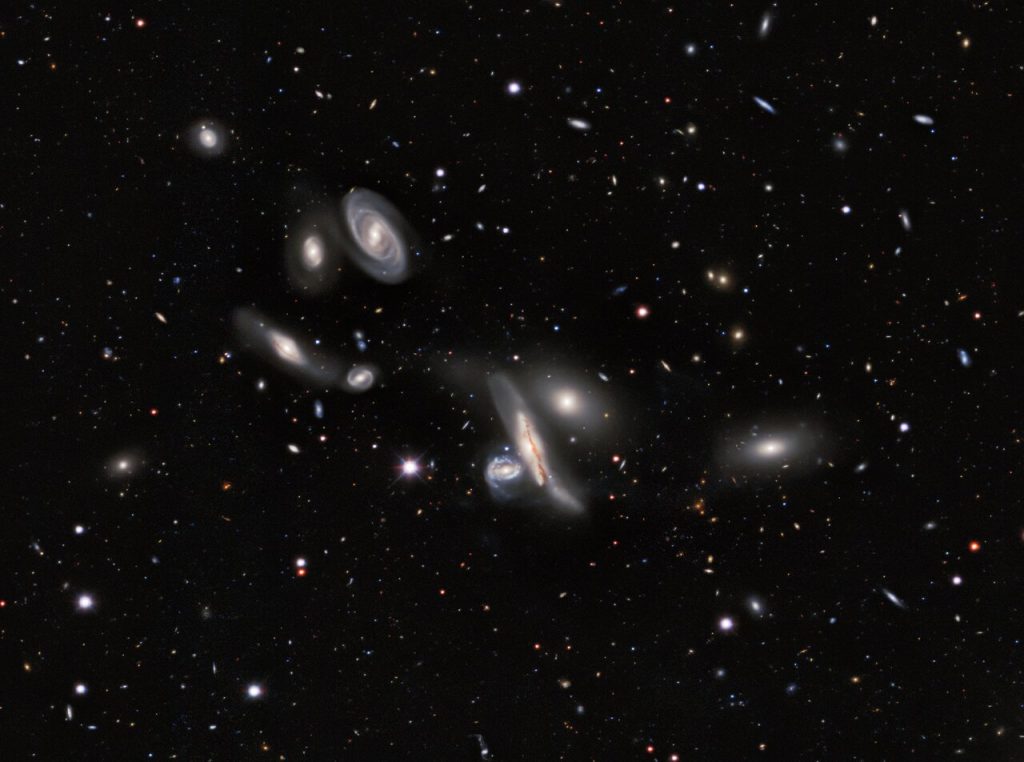
Earlier I mentioned the Dark Energy Spectroscopic Instrument (DESI), which is a brand-new instrument installed at the Kitt Peak National Observatory (KPNO). It’s ready to come online, and it follows on the heels of the DESI Legacy Imaging Surveys.
This ambitious six-year project involved over 1400 nights of observations, three ground-based telescopes, several years’ worth of space telescope data, 150 observers, and another 50 researchers from all over the world. It included one petabyte of data and 100 million CPU hours on one of the most powerful computers. All to create a two-dimensional map of the sky in preparation for mapping the sky in three dimensions using this new instrument, a survey which is expected to take another five years.
The current map covers half of the sky and contains 10 trillion pixels. Ten. Trillion. Whew. And from all of that data, we have a couple of interesting stories. Pamela?
This kind of amazing imagery allows us to find small faint images of different objects that sometimes get smeared out by an effect called gravitational lensing. As weird as it may seem, light is just a fast-moving particle, and its path can be bent by the gravitational pull of any object that light shines past.
Large objects, like massive galaxies, can even act as a funhouse mirror, allowing us to see objects around corners, but twisted and distorted. The thing is, as twisted and distorted as those objects may appear, we aren’t necessarily able to see them any other way. The gravity is actually able to redirect more light in our direction making distant objects also appear brighter. And the objects we’re able to see are some of the earliest galaxies in the universe.

One of the things we don’t acknowledge nearly often enough is that light lets us look back in time. When we look at the sun, we see the light that was released eight minutes ago. When we look at galaxies like the nearby Andromeda we’re looking at light that has been traveling for millions of years, showing us what was instead of what is. As we look at the light that has been traveling from more and more distant galaxies, we are actually seeing what the galaxies looked like at earlier and earlier times in our universe. Through the light-focusing power of gravitational lenses, we’re able to see systems in which the first stars are forming.
Gravitational lenses can also do some pretty weird things. Sometimes, light from the same distant object will get bent toward us along two different paths, and if something flickers or flashes in that distant object — something like a supernova — we’ll see the light arriving at two different times. This effect, and other ways we can measure the distance the light travels, actually let us start to measure the expansion of the universe.
Basically, gravitationally lensed distant galaxies are weird and beautiful and are able to help us understand our universe in a myriad of ways.
And finding them requires amazing data — the kind of data the DESI Legacy Imaging Surveys contain. This single survey has doubled the number of known lenses. The science team is still at the stage of identifying them and working on the science, but like finding a perfectly preserved shipwreck with a bunch of locked chests on the seafloor, we know we have found something, we know it will be amazing, and now we’re just waiting for the details to be unlocked.
DESI is such an amazing survey, and its data is being used for several studies. Citizen scientists from the Backyard Worlds: Planet 9 survey delved into the data they were provided and helped put together a 3D map of nearby brown dwarfs. We’ve talked about brown dwarfs before on the show, and to quickly recap, they are very cool, very large objects — much bigger than Jupiter — that didn’t have enough mass to start nuclear fusion and become active stars. Because they are cool and usually not orbiting another star, they are very difficult to find.
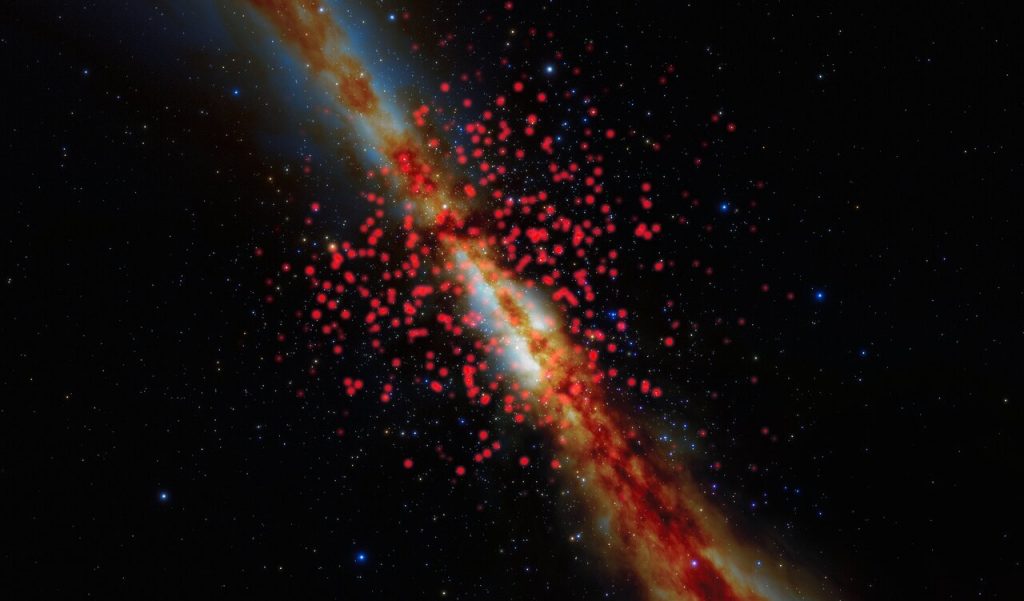
This new map shows the location of 525 brown dwarfs, all within 65 light-years of the Sun, and includes 38 brand new discoveries. Yesterday’s announcement at the AAS meeting continues a story we covered back in August of last year where the Backyard Worlds project announced the discovery of nearly 100 brown dwarfs. Co-author Aaron Meisner commented: The Backyard Worlds project shows that the general public can play an important role in cutting-edge astronomy. Volunteers ranging from high school students to retired engineers are helping uncover groundbreaking discoveries lurking in existing telescope data.
And lead author J. Davy Kirkpatrick summed up the work: Brown dwarfs are the low-mass byproducts of the process that forms stars, yet the least massive of them have many characteristics in common with exoplanets. They’re exoplanet laboratories, but since they are usually by themselves and lack the complications caused by a blinding host sun, they’re much easier to study.
We look forward to more work from this study and the citizen scientists involved. The paper will appear in The Astrophysical Journal Supplement.
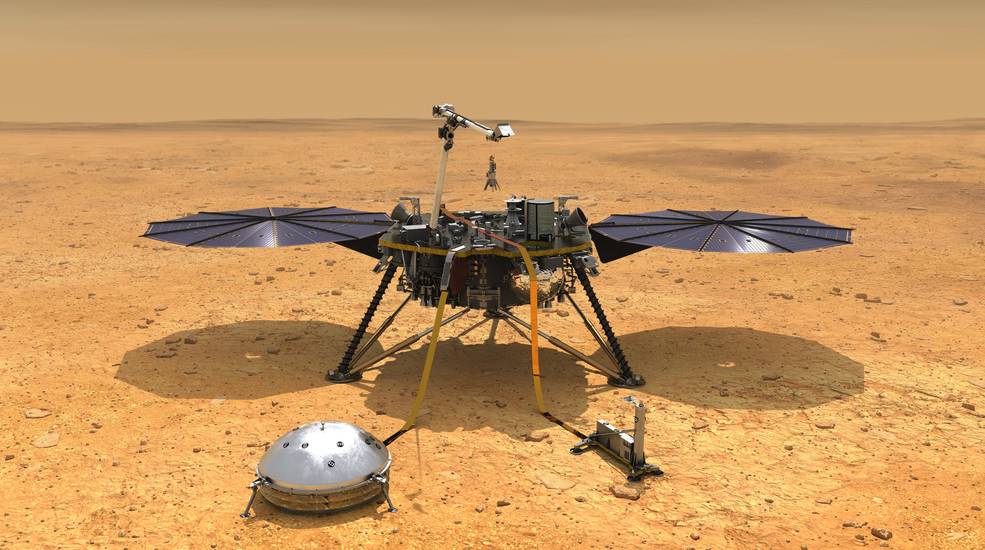
While all the new science coming out of AAS is amazing, the day-to-day work of space exploration is still going on in the background. One of the things we don’t like to think about is budgets and working out what programs will and won’t get funding in the future. For a change, we have good news on the budget front. Reviewers looking at the progress being made by the InSight mission on Mars and the Juno mission at Jupiter have determined both science missions are going well and still have a lot of science worth supporting that they can do.
The InSight mission is extended thru December 2022. This lander is currently sitting on the surface of Mars measuring weather and seismic activity and trying and failing to dig down through the Martian soil. Continuing to try and burrow through the Mars landscape will be the lowest priority for this continuing mission; efforts will instead be focused on continuing to measure Mars’ seasonal weather variations and in monitoring what turns out to be the active shakes, rattles, and rolls that rock the Red Planet
The Juno mission is being renewed through September 2025 or the end of its life, whichever comes first (which kind of makes sense). Not only that, but the mission is being expanded to include three of the Galilean moons – Ganymede, Europa, and Io. Those of you that know me, probably assume I did a happy dance or some such at the news, and you would be correct.

The extended mission will include another 42 additional orbits of the system, including some close passes of the north polar cyclones and flybys of the aforementioned moons. Additionally, Juno is tasked with exploring Jupiter’s ring system. All of the data collected will advance goals for NASA’s solar system exploration strategy, being passed forward for the upcoming Europa Clipper and JUICE missions. Exploring Io is part of the National Academy of Sciences’ plans for a future Io mission, and I am all for that.
How is this mission going to keep going? They’re doing a fantastic job of conserving fuel. Juno project manager Ed Hirst explained: The mission designers have done an amazing job crafting an extended mission that conserves the mission’s single most valuable resource — fuel. Gravity assists from multiple satellite flybys steer our spacecraft through the Jovian system while providing a wealth of science opportunities.
Go, go, Juno!
It’s now time for our weekly What’s Up feature.
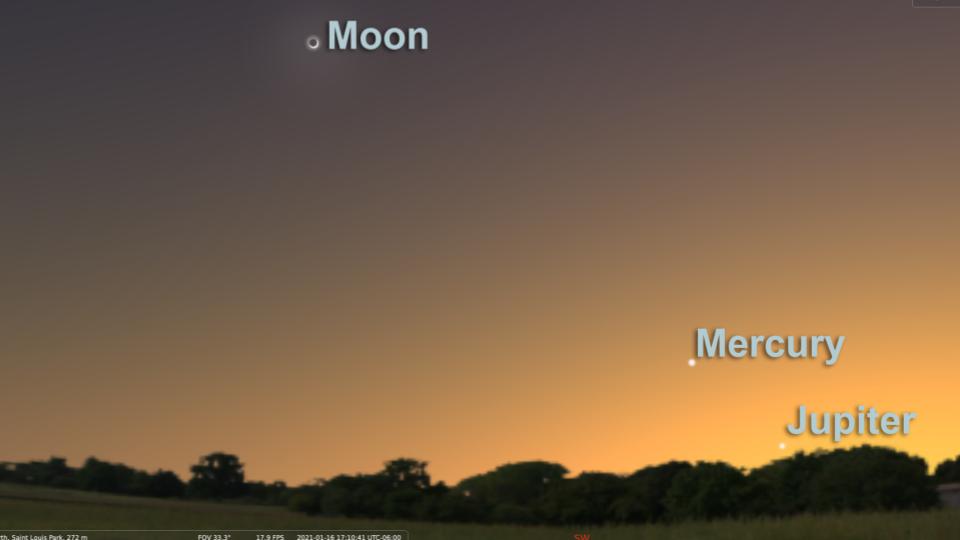
Depending on where you live, your sky may or may not be dark enough to take in a lot of stars, but as long as you have a cloud-free night, the Moon should be visible. This weekend, the Moon will be a thin crescent, visible in the west after sunset. This kind of moon is often called a horned moon because as it sinks into the horizon, chasing the Sun down after sunset, the curve of the Moon faces the Earth while the tips of the crescent moon point up. Just how dramatic this appears will depend on where you are on the planet, but no matter where you are, the Moon is showing you where the Sun is: that curved edge of the crescent always points toward the Sun.
Along that line from the Moon’s curve toward the west-setting Sun, Jupiter and Mercury will be hiding in the twilight shortly after sunset. If you are down on the beach facing southwest, you may be able to see them with binoculars.
Looking south, you can also watch the great winter constellation Orion rise to stand tall around 10 pm for folks in the northern hemisphere. If you’re in the southern hemisphere, you’ll want to look north, and he’ll be standing on his head at the same time of night.
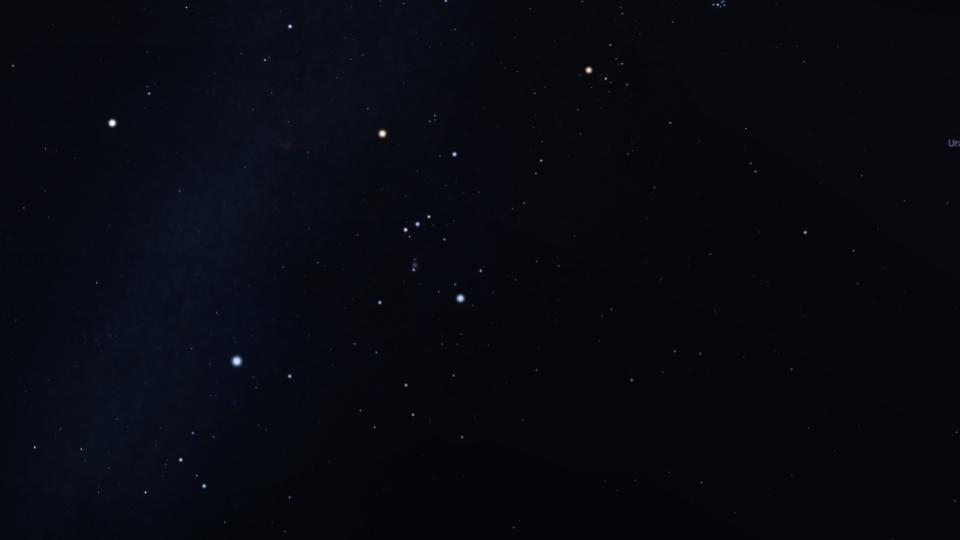
No matter how you see Orion, this is the time of year you want to look. With the Moon just a sliver, people in darker locations will be able to make out the faint glow of stars forming along Orion’s sword, and we can all, no matter how bad the light pollution, enjoy the once again bright red star Betelgeuse shining. In about 100,000 years, we expect Betelgeuse will explode, creating a supernova visible during the day and an expanding red nebula that will eventually make Orion the Hunter look like Taurus the Bull managed to injure him.
Speaking of Taurus, it also has a bright red star. Or, as Pamela insists on saying, a burnt orange Texas Longhorns colored star. This star, Aldebaran, is the eye of Taurus and currently marks the part of the sky the asteroid 16 Psyche is passing through.
If you have a 4” or larger telescope, you may be able to see this asteroid as a point of light that moves over tens of minutes. This asteroid is metal-rich, particularly in iron and nickel. Planetary scientists think it could have been the core of a small planet that either failed to completely coalesce or was broken apart by the pull of Jupiter’s gravity. Understanding Psyche’s origin could advance our understanding of our solar system’s formation, so scientists are analyzing every bit of data they can. Unfortunately, this rock doesn’t look like more than a moving speck in even the Earth’s largest scopes. To learn more, NASA will be sending a mission to Psyche. This orbiter is targeted for launch in 2023 and should arrive at this speck of light in 2026.
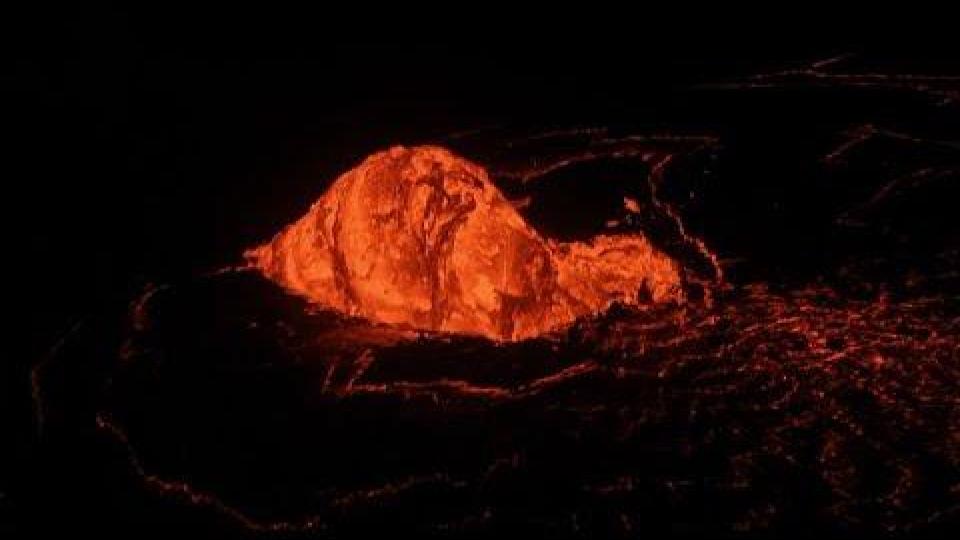
One final story. Pamela is a volcano fangirl, as am I. And while we’re telling you all to look up, we’d like to remind you that sometimes, you have to look down and check out Earth, too. We live on a fascinating planet, and we’ve managed to catch our amazing world in the act of being, well, amazing. With the proliferation of webcams, watching volcanoes is even easier, and the USGS has uploaded a fantastic video of a lava dome forming from the lava lake inlet of Halema’uma’u crater earlier in the year.
The USGS explains: Dome fountains can occur when lava rapidly emerges from a constricted vent or fissure onto the surface or, as in this case, beneath the surface of a lava lake. The feature resembles, in part, a bubbling water fountain. The height of the dome fountain was estimated to be about 5 m (16 ft) with an estimated width of 10 m (33 ft).
This has been the Daily Space.
Learn More
Powerful Gamma-Ray Burst Turns Out to be Magnetar Flare
- UC Berkeley press release
- NASA press release
- USRA press release
- Rice University press release
- “A bright γ-ray flare interpreted as a giant magnetar flare in NGC 253,” D. Svinkin, D. Frederiks, and R. Starr, 2021 January 13, Nature
- “Rapid spectral variability of a giant flare from a magnetar in NGC 253,” O.J. Roberts et al., 2021 January 13, Nature
- “High-energy emission from a magnetar giant flare in the Sculptor galaxy,” The Fermi-LAT Collaboration, 2021 January 13, Nature Astronomy
DESI Legacy Imaging Surveys
Number of Gravitational Lenses Doubles
- LBNL press release
- NOIRLab press release
- “Discovering New Strong Gravitational Lenses in the DESI Legacy Imaging Surveys,” X. Huang et al., to be published in The Astrophysical Journal (preprint on arxiv.org)
Citizen Scientists Build 3D Map of Over 500 Nearby Brown Dwarfs
- NASA press release
- NOIRLab press release
- “The Field Substellar Mass Function Based on the Full-sky 20-pc Census of 525 L, T, and Y Dwarfs,” J. Davy Kirkpatrick et al, to be published in Astrophysical Journal Supplement (preprint on arxiv.org)
NASA Extends InSight and Juno Missions
What’s Up: January 14-20, 2021
Credits
Written by Pamela Gay and Beth Johnson
Hosted by Pamela Gay and Beth Johnson
Audio and Video Editing by Ally Pelphrey
Content Editing by Beth Johnson
Intro and Outro music by Kevin MacLeod, https://incompetech.com/music/

 We record most shows live, on Twitch. Follow us today to get alerts when we go live.
We record most shows live, on Twitch. Follow us today to get alerts when we go live.